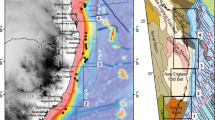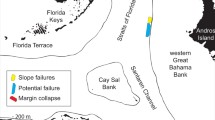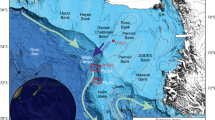Abstract
Morphologic characterisation of five distinct, eastern Australian upper continental slope submarine landslides enabled modelling of their tsunami hazard. Flow depth, run-up and inundation distance has been calculated for each of the five landslides. Future submarine landslides with similar characteristics to these could generate tsunami with maximum flow depths ranging 5–10 m at the coastline, maximum run-up of 5 m and maximum inundation distances of 1 km.
Title of Team: Shipboard Party SS12/2008
Access this chapter
Tax calculation will be finalised at checkout
Purchases are for personal use only
Similar content being viewed by others
References
Boyd R, Keene J, Hubble T, Gardner J, Glenn K, Ruming K, Exon N (2010) Southeast Australia: a Cenozoic continental margin dominated by mass transport. In: Mosher DC et al (eds) Submarine mass movements and their consequences, vol 28, Advances in natural and technological hazards research. Springer, Dordrecht, pp 491–502
Chesley SR, Ward SN (2006) A quantitative assessment of the human and economic hazard from impact-generated tsunami. Nat Hazards 38(3):355–374
Clark DJ (2010) Large earthquake recurrence in New South Wales: implications for earthquake hazard. Earthquake hazard project. Geoscience Australia, Canberra
Clarke S, Hubble T, Airey D, Yu P, Boyd R, Keene J, Exon N, Gardner J (2012) Submarine landslides on the upper southeast Australian passive continental margin – preliminary findings. In: Yamada Y, Kawamura K, Ikehara K et al (eds) Submarine mass movements and their consequences, vol 31, Advances in natural and technological hazards research. Springer, Dordrecht, pp 55–66
Dominey-Howes D (2007) Geological and historical records of tsunami in Australia. Mar Geol 239:99–123
Driscoll NW, Weissel JK, Goff JA (2000) Potential for large-scale submarine slope failure and tsunami generation along the U.S. mid-Atlantic coast. Geology 28(5):407–410
Fine IV, Rabinovich AB, Bornhold BD, Thomson RE, Kulikov EA (2005) The Grand Banks landslide-generated tsunami of November 18, 1929: preliminary analysis and numerical modeling. Mar Geol 215:45–57
Fryer GJ, Watts P, Pratson LF (2004) Source of the great tsunami of 1 April 1946: a landslide in the upper Aleutian forearc. Mar Geol 203(3–4):201–218
Gerardi F, Barbano MS, De Martini PM, Pantosti D (2008) Discrimination of tsunami sources (earthquake versus landslide) on the basis of historical data in eastern Sicily and southern Calabria. Bull Seismol Soc Am 98(6):2795–2805
Hsu S-K (2008) Turbidity currents, submarine landslides and the 2006 Pingtung earthquake off SW Taiwan. TAO: Terr Atmos Ocean Sci 19(6):767
Hubble T (2013) Voyage summary SS2013-V01: marine geology and geohazard survey of the SE Australian Margin off Northern NSW and Southern Queensland. CSIRO, Hobart
Hubble T, Yu P, Airey D, Clarke S, Boyd R, Keene J, Exon N, Gardner J (2012) Physical properties and age of continental slope sediments dredged from the eastern Australian continental margin – implications for timing of slope failure. In: Yamada Y et al (eds) Submarine mass movements and their consequences, vol 31, Advances in natural and technological hazards research. Springer, Dordrecht, pp 43–54
Keene J, Baker C, Tran M, Potter A (2008) Geomorphology and sedimentology of the East Marine Region of Australia. Record 2008/10. Geoscience Australia, Canberra, 262 pp
Masson DG, Harbitz CB, Wynn RB, Pedersen G, Lovholt F (2006) Submarine landslides: processes, triggers and hazard prediction. Philos Trans R Soc A 364:2009–2039
McAdoo BG, Pratson LF, Orange DL (2000) Submarine landslide geomorphology, US continental slope. Mar Geol 169(1–2):103–136
Short AD, Woodroffe CD (2009) The coast of Australia. Cambridge University Press, New York
Sue LP, Nokes RI, Davidson MJ (2011) Tsunami generation by submarine landslides: comparison of physical and numerical models. Environ Fluid Mech 11(2):133–165
Tappin DR, Watts P, McMurtry GM, Lafoy Y, Matsumoto T (2001) The Sissano, Papua New Guinea tsunami of July 1998 – offshore evidence on the source mechanism. Mar Geol 175(1–4):1–23
Varnes DJ (1978) Slope movements and types and processes. Landslides: analysis and control, special report, vol 176. Transportation Research Board, National Academy of Sciences, Washington
Ward SN (2001) Landslide tsunami. J Geophys Res 106:11201–11215
Ward SN (2011) Tsunami. In: Gupta HK (ed) Encyclopedia of earth sciences series. Springer, Dordrecht, pp 1473–1493
Acknowledgments
We would like to acknowledge the P&O crew and scientific crews of the RV Southern Surveyor voyage (12/2008). Funding for this voyage was provided by ARC Australia and ConocoPhillips Pty Ltd. This paper benefitted from reviews by Dr Geoffroy Lamarche and Dr Julie Dickinson.
Author information
Authors and Affiliations
Corresponding author
Editor information
Editors and Affiliations
Rights and permissions
Copyright information
© 2014 Springer International Publishing Switzerland
About this chapter
Cite this chapter
Clarke, S. et al. (2014). Morphology of Australia’s Eastern Continental Slope and Related Tsunami Hazard. In: Krastel, S., et al. Submarine Mass Movements and Their Consequences. Advances in Natural and Technological Hazards Research, vol 37. Springer, Cham. https://doi.org/10.1007/978-3-319-00972-8_47
Download citation
DOI: https://doi.org/10.1007/978-3-319-00972-8_47
Published:
Publisher Name: Springer, Cham
Print ISBN: 978-3-319-00971-1
Online ISBN: 978-3-319-00972-8
eBook Packages: Earth and Environmental ScienceEarth and Environmental Science (R0)




